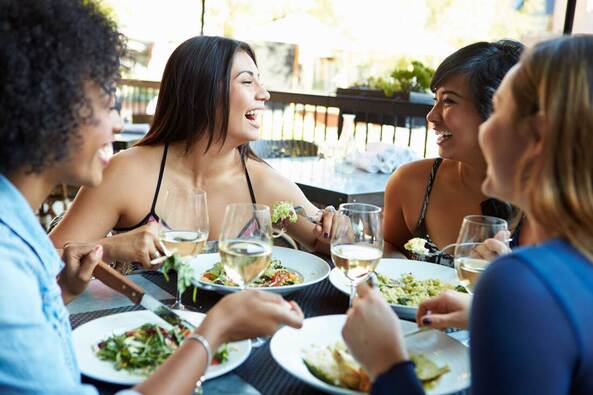 As operators weather what is likely going to be a difficult winter, many of those fortunate enough to have outdoor spaces have taken steps to outfit them with heated pods, screens and other partitions aimed at containing the spread of the virus while also allowing the safe (and more comfortable) serving of guests as the temperature drops. But according to medical experts, these spaces can be as risky as indoor settings if operators don’t take sufficient precautions. To minimize the spread of infection in the next couple of months, be sure to air out individual dining pods between guests, or in case you have a partially enclosed space for dining outdoors, ensure that air is able to circulate throughout it. Outdoor space heaters and fireplaces can help beat the chill without posing additional safety risks, and you can also encourage guests to bring their own blankets to keep warm during their meal.
0 Comments
Source: Modern Restaurant Management by: Bob Lester  COVID-19 has forced restaurant owners and operators to turn their operational strategies on a dime. After reopening in May and June, the CDC and state governments provided guidance for inside dining, but even with reduced seating, 73 percent of people are uncomfortable dining indoors at a restaurant. As a result, the industry is seeing a tenfold increase in outdoor seating compared to this time last year. For operators that don’t already have an existing space designated for outdoor dining, this is a challenge. Many restaurants are having to improvise to create outdoor seating arrangements, and typically they're turning to their parking lots … but it can also be a challenge to transition these spaces safely. To make sure consumer health and safety is prioritized, operators should be auditing lots for quick repairs, adjusting signage to control traffic, as well as taking care of outside factors like city permits and permissions. Auditing Lots for Damage and Quickly Conducting RepairsWhen transitioning restaurant lots to dining space, operators will have to quickly audit lots for damage and get repairs scheduled and completed before opening the space. Looking for items like potholes, cracks, and rutting – which is when the pavement shows grooves from wear and tear – should be high priority during the audit process. Identifying these problems ahead of calling a contractor can help to expedite the repair process by setting expectations early about the kinds of repairs the site needs. During the auditing process, gathering a quantitative level of damage and the severity of damage should be the two focal points. Quantitative damage level will document the number of damaged areas a lot has. The severity of the damage will help provide contractors with context on the level of damage, so they can come up with a solution that is best for the longevity of the lot. These two pieces of data will help a paving contractor provide a realistic estimate and timeline for repairs. With how quickly contractors are booking up – knowing that many businesses are seeking out services to better utilize their outdoor spaces – this should be the first step in the transition process. Adjusting Signage to Control Traffic Taking parking lot space and turning it into dining space outside redirects the flow of traffic in a parking lot. To make sure people know where to park and which ways to drive, restaurant operators need to be diligent about creating new signage that clearly defines new traffic flow. Some signs to consider are:
Handling Outside Factors and City Permissions While permissions for outdoor dining differ based on location, restaurant owners should always check with city health officials on which permits are required, as well as which guidelines must be followed. Most cities have a form on their website for operators to submit a request for an outdoor dining permit. For example, L.A.’s mayor is allowing permits to be submitted and approved digitally, and permits will last for 90 days. In L.A., bars that have liquor licenses are also allowed to serve alcohol within the approved outdoor space. Many cities have specific, individual guidelines for outdoor dining during the pandemic that include distancing protocols, numbers of walking lanes, barricades, and the square footage allowed. Some cities have designated specific streets for outdoor dining, as well as specific instructions for sidewalk dining and curb lanes. At this point, most restaurants have to submit a request for approval for parking lot dining, but the majority of cities have streamlined the process to rush these requests throughout COVID-19. Amid all the uncertainty, one thing is certain: restaurant owners need to act quickly to transition to expand outdoor dining space. Since the majority of consumers continue to be uncomfortable dining indoors and the pandemic shows no signs of fizzling out over the next several months, creating outdoor dining space will help bolster business for restaurants during these challenging times. Prioritizing conversations with a trusted paving contractor, signage vendor, and city officials will help owners stay on top of the transition and weather the storm of the pandemic. Bob LesterBob Lester is president and CEO of Dura-Seal, a sealcoating, asphalt, and concrete services company. He has worked in the paving industry for more than 20 years, leading two buyouts, an acquisition, and the sale of an equipment manufacturing company at Dura-Seal. |
More safety resourcesCleaning resourcesClean it and communicate itMake sure your outdoor dining area protects safetyEnsure-your-parking-lot-is-safe-for-outdoor-dining.htmlEnsure Your Parking Lot Is Safe for Outdoor DiningAn employee has Covid, should you close your restaurant?ArchivesCategories
All
|
Foodservice CEO is provided for informational purposes only. It is intended to offer foodservice operators’ guidance regarding best practices in running their operations. Adherence to any recommendations included in this Guidance will not ensure a successful operation in every situation. Furthermore, the recommendations contained in this website should not be interpreted as setting a standard of operation or be deemed inclusive of all methods of operating nor exclusive of other methods of operating.
Copyright 2023 Team Four Foodservice, All Rights Reserved.




 RSS Feed
RSS Feed